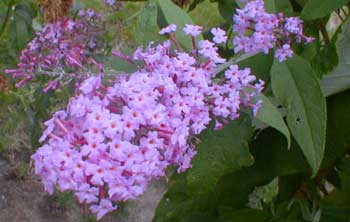
'Mongo' aka 'Nanho Purple'
aka 'Petite Plum' Butterfly Bush
or Summer Lilac
"I'd be a butterfly born in a bower."
-Thomas Haynes Bayly
(1797-1839)
(1797-1839)
Butterfly bushes are excellent choices of shrubs to make central to a butterfly garden, for they really do attract & feed butterflies, so much so that one should be reluctant to commit summer pruning if such a shrub is hung with chrysalids.
My alley neighbor John planted two butterfly bushes practically in the same hole, or so close to one another that they enwrapped one another as they matured & now seem to have one big root system. While such crowding isn't wise, it has been working out pretty well for several years.
The larger 'White Profusion' butterfly bush is in full flower July & early August, & the smaller Buddleia davidii var nanhoensis 'Nanho Purple' flowers a bit later in summer (August & early September).
Their flowers don't much overlap but that is probably due to John's aggressive pruning schedule. He doesn't care for the look of the dried flowers so trims back the white dramatically after its first flush of bloom just as the lilac-blue 'Nanho Purple' is taking over. Also the 'Nanho' might start blooming earlier if it weren't competing with the tougher 'White Profusion.'
John keeps both bushes cut short with a major late summer or autumn hard pruning & a fairly major post-flowering pruning when the white is finishing up its main summer flush of flowers. If John let the double-bushes grow large & fountaining, the long bloom-time for these shrubs would undoubtedly overlap especially in August, but the bigger white would probably eventually so overshadlow the semi-dwarf 'Nanho Purple' that the latter would dwindle over time. These shrubs can survive pruning at just about any time of the year, but because it flowers on the previous year's wood, post-flower pruning is best. If pruned heavily in Spring, it will regrow rapidly but won't much flower that summer.
John's 'Nanho Purple' is not as floriferous as his 'White Profusion' because it is being out-competed by the white or perhaps because it gets its own buds accidently sheared during the summer post-bloom trimming of the white. John's methods work well for what he requires, as this ultra-crowded pair is close to the sidewalk & his front yard is fairly small, so keeping the shrubs compact with hard prunings is essential.
A choice of something naturally smaller might have been better for that spot, but on the other hand, there are rarely dried flowers left on the branches & the double-shrub is always tidy, compact, & flowerful, whereas my own 'Nanho Blue' which I hadn't been pruning very much became a slovenly shrub that imposed so much on the sidewalk that it became a nuisance, & was often a crummy mix of dried & fresh flowers rarely with all-fresh flowers as John gets on his. So John's aggressive pruning results in a small, restrained, redolently flowerful double-shrub that is flowering white then lilac-plum from having two cultivars planted practically on top of each other, a very interesting effect.
I had about decided to sacrifice my 'Nanho Blue' because the elderberry had grown so large there wasn't room in that mixed deciduous hedge for both. But following John's method I have instead begun to aggressively prune mine as he does his, & if it results in a tidier small shrub that still blooms well, that'll be good.
'Nanho Purple' is also sold under its actual recorded cultivar name 'Mongo' & under the Trademark name 'Petite Plum.' Variants of the name creep into nursery labels like 'Dwarf Purple' or 'Petite Purple' or 'Nanho Plum' & so forth. Such cultivars of the variant nanhoensis are easily kept in the three to six foot size range (five by four feet average) if it receives an annual hard prune. But left alone it will become twelve or fifteen feet tall & wide, which is still very small compared to the species.
Butterfly bushes want fullest sun & will bloom feebly or not at all if placed in shade. They want little or no watering, in extremely well-draining soil especially if placed in a location with occasional irrigation, though tolerating all sorts of poor soil as long as soil doesn't keep the roots wet. There are very few summer-flowering shrubs that will bloom for as long this redolently, the wild honey scent being one of the best odors of any garden.